Reviews
Anthony Mann
USA, 1944
Credits
Review by Glenn Heath Jr.
Posted on 22 January 2013
Source DVD
Categories Noir Mann
What is it with Anthony Mann and high perches? So many of the director’s more memorable climaxes, including the final shootouts in The Naked Spur and Man of the West, take place atop elevated rock faces, crevices, and cliffs. Extreme angles dominate Mann’s finales; these scenes usually end in stunning fashion with gut-shot characters tumbling into rivers, down jagged edge terrain, and through densely packed forests before meeting their maker. But like many of the great Western filmmakers, Mann sees location and theme as organically connected, mirror images of each other. This consistent focus on physical precipices is tied to his obsession with moral pitfalls, more specifically how driven but flawed characters become ideologically compromised over time, their sense of control slowly ripped out from under their feet.
It’s a motif that holds true for Mann’s down-and-dirty Noirs too, a series of swift cinema grenades made in the 1940s before his shift to the stories set in the wild west. Fittingly, menacing and opulent interiors, steep stairways, and dusty windows stand in for the angular Western vistas, creating a far more suffocating aesthetic overall. Strangers in the Night, a 52-minute oddity about a WWII vet named Johnny who stumbles into a very disturbing matchmaking situation upon returning stateside to visit his young female pen pal, is mostly set in and around the small coastal town of Monteflores. High vantage points are key to both the narrative and scope of its central location, a massive hillside mansion that overlooks the Pacific ocean. The opening frames are captured from extreme high angle looking down from the mansion at the crashing waves and submerged rocks below. Do these images represent a specific character’s increasingly fragile perspective, or Mann’s notorious desire to look over the edge into the moral abyss?
Fate and chance subvert much of Strangers in the Night. Take for example the manically jumbled opening act, which follows Johnny as he travels to Monteflores with the hopes of confessing his undying love to Rosemarie, the young woman whose letters have provided him a sense of solace while fighting in the Pacific campaign. But by happy accident on the train Johnny meets the lovely and talented Dr. Leslie Ross, the town’s new independent and strong physician who just happens to be reading the exact book which spawned his correspondence with Rosemarie. To further convolute matters, Mann throws in a doozy of a melodramatic curveball. Just as the two are about to meet cute, the train suddenly derails in brutal fashion. Not only does this tragic accident allow Dr. Ross to flex her professional muscles, treating a multitude of patients until the paramedics arrive, it rattles Johnny’s sense for the duration. In regard to both gender roles and character motivation, up is down, and down is up from here on out.
A bit dazed and confused, Johnny finally arrives at his destination, the aforementioned spooky house on the hill. Not only is Rosemary entirely absent, he’s greeted by her creaking elderly mother, Hilda, who explains that her daughter is away and will be back in a few days. She plants the young stud in front of a giant portrait of Rosemary to keep him interested and the waiting game begins. From the anxiety and uncertainty created by this situation, Mann doesn’t build suspense as much as he flirts with the idea that perversion is not simply a young person’s cross to bear. As Hilda limps around the cavernous estate seemingly aroused by Johnny’s presence, smiling maniacally and intimidating her obviously-frightened servant for the hell of it, Mann gives us the keen sense that we are watching a deeply disturbed individual come unhinged. Hilda’s warped sense of reality is completely singular in the grand spectrum of demented villains, her increasing panic and desperation at the thought of failure a marker of volatile fundamentalism.
During it’s wobbly home stretch, Strangers in the Night propels forward solely on Hilda’s mania. The fact that she is a German living in America post WWII makes the scenario an even stranger portrait of 1940s America. Interestingly, her disturbing affection for Johnny and the youthful blind hope he represents is skewed until the bitter end. While Mann gives us yet another showdown atop a high vantage point, what’s most interesting is how the director uses the mansion’s interiors to convey a nasty sense of Final Destination-like mortality. Hilda’s hilariously sudden demise, maybe the only death-by-painting film history has ever seen, is punctuated by a line of dialogue that speaks to the film’s deceptively brutal sense of humor. As Johnny and Dr. Ross look on in shock, the young soldier waxes eloquently about the lump of irony lying dead in front of him: “A fellow makes it through Guadalcanal and …” Like every crucial moment in Strangers in the Night, Johnny’s sentence is interrupted. You just never know when crazy is going to walk through that door and smack you in the cheek.
More Noir Mann
-
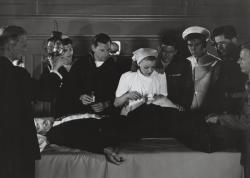
Strangers in the Night
1944 -
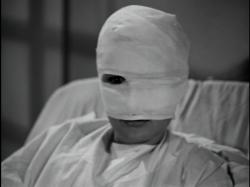
Strange Impersonation
1946 -
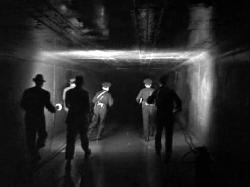
He Walked By Night
1948 -
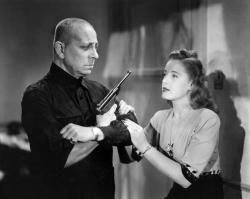
The Great Flamarion
1945 -
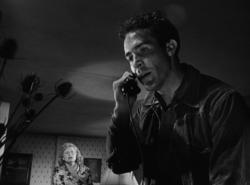
Border Incident
1949 -
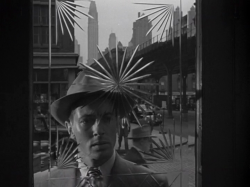
Side Street
1950 -
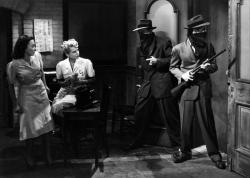
Railroaded
1947
We don’t do comments anymore, but you may contact us here or find us on Twitter or Facebook.



